glenn bradley
Member
- Messages
- 11,551
- Location
- SoCal
I hope I haven't already done this
 .
.
I use a shop made flexible sanding block for things like the Scott Lewis cutting board. If you've ever done box joints you already know how to do this. Special jigs are nice but lets pretend all we have is a miter gauge and a sacrificial fence. I use 3/4" MDF so that's what I will demonstrate here. Set your FTG or TCG blade at about 1/8" from the stock's thickness height. Use a blank that is about a foot longer than the block you will cut off of it.

Attach a sacrificial fence to your miter gauge and make a cut through your blank and the fence. Please ignore the second narrow cut in the sac fence. That is left over from something else. My block is short because I have a method of dealing with that. Let's just pretend my blank is about a foot longer.

The cut that you just made through the block and the sac fence gets a key installed on the sac fence. I use a little Rapid Fuse and a piece of 1/8" hardboard. This doesn't have to be perfect.
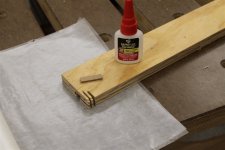
Space you fence so that the key is to the right of the blade the same dimension as the kerf width. This is 1/8" in my case.
 .
. 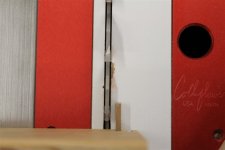
Set the cut you made in your blank over the key.
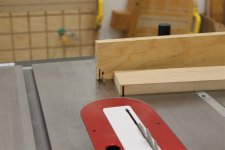
You can see where this is going . . .
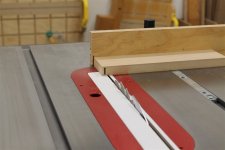
Make a through cut, hop the blank over so that the cut you just made sets on the key. Cut again, hop, cut, hop, cut . . .
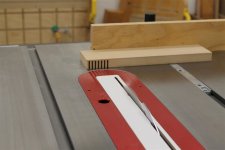
Do this for the length that you want your block. For 3/4" MDF a block about a foot long has some reasonable flex.
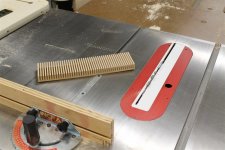
Some folks use "bendy ply" and that is fine. I didn't have any handy and so went with MDF. The bendy ply will make a tighter curve. The MDF will do about a 12" radius max. This works fine for the cutting boards of the type discussed.
I use a shop made flexible sanding block for things like the Scott Lewis cutting board. If you've ever done box joints you already know how to do this. Special jigs are nice but lets pretend all we have is a miter gauge and a sacrificial fence. I use 3/4" MDF so that's what I will demonstrate here. Set your FTG or TCG blade at about 1/8" from the stock's thickness height. Use a blank that is about a foot longer than the block you will cut off of it.

Attach a sacrificial fence to your miter gauge and make a cut through your blank and the fence. Please ignore the second narrow cut in the sac fence. That is left over from something else. My block is short because I have a method of dealing with that. Let's just pretend my blank is about a foot longer.

The cut that you just made through the block and the sac fence gets a key installed on the sac fence. I use a little Rapid Fuse and a piece of 1/8" hardboard. This doesn't have to be perfect.

Space you fence so that the key is to the right of the blade the same dimension as the kerf width. This is 1/8" in my case.
 .
. 
Set the cut you made in your blank over the key.

You can see where this is going . . .

Make a through cut, hop the blank over so that the cut you just made sets on the key. Cut again, hop, cut, hop, cut . . .

Do this for the length that you want your block. For 3/4" MDF a block about a foot long has some reasonable flex.

Some folks use "bendy ply" and that is fine. I didn't have any handy and so went with MDF. The bendy ply will make a tighter curve. The MDF will do about a 12" radius max. This works fine for the cutting boards of the type discussed.
